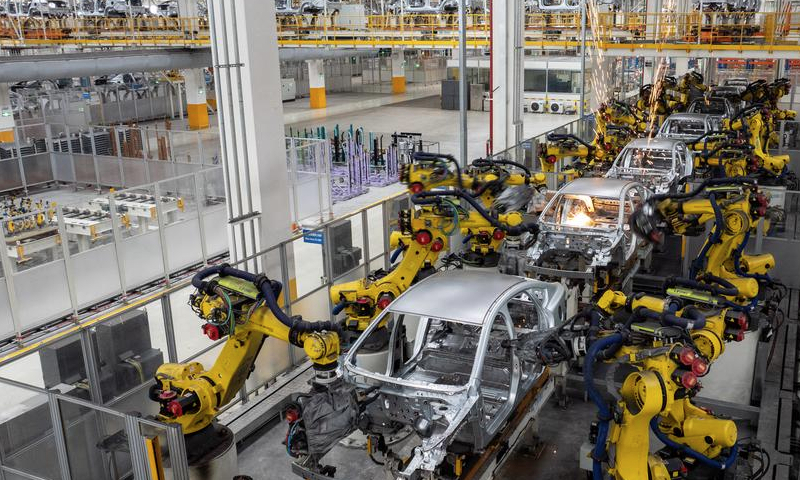
This photo taken on March 21, 2024 shows a production line of BYD, China's leading new energy vehicle (NEV) manufacturer, in Changsha, central China's Hunan Province. (Xinhua/Chen Sihan)
China's major battery maker CATL recently launched a new electric vehicle (EV) chassis that can withstand a high-speed frontal impact at 120 km/h without catching fire, exploding, or causing any spread of damage, injecting new momentum into the innovative development for new energy vehicles (NEVs).The new integrated chassis, named the "Bedrock Chassis," features a design that centers around the battery, directly integrating the battery cells into its structure.
This innovation enhances vehicle safety by absorbing 85 percent of the total collision energy in a crash, compared with some 60 percent absorbed by a standard chassis, according to the company.
Innovation has become the focal point of China's NEV sector over the past year, highlighted by the country's remarkable achievement of producing over 11 million NEVs in the first 11 months of the year.
Among the booming Chinese automakers, BYD reached a milestone last month when its 10-millionth NEV rolled off the production line.
Committed to technology as a key driver of its success, BYD plans to invest 100 billion yuan (about 13.9 billion U.S. dollars) to integrate artificial intelligence with automotive technologies, aiming to achieve a comprehensive upgrade in vehicle intelligence, according to the company's chairman Wang Chuanfu.
The rapid growth of China's NEV industry is driven not only by the country's strong innovation but also by the government's commitment to green development and sustainable transformation. These efforts have significantly stimulated market demand for NEVs, fueling the industry's expansion.
According to official data, China's NEV market share was just over 1 percent in 2015 but has since surged. In July this year, NEVs surpassed fuel-powered vehicles in market share for the first time, with retail sales reaching 878,000 units, accounting for 51.1 percent of the domestic market.
"China's active development of NEVs is primarily driven by increasing demand from domestic consumers. In terms of sales structure, the focus is on domestic sales, with exports accounting for a relatively small proportion," said Bai Ming, a researcher with the Chinese Academy of International Trade and Economic Cooperation under the Ministry of Commerce.
China's Ministry of Industry and Information Technology, in collaboration with four other government bodies, launched a nationwide campaign to promote NEVs in rural areas. The initiative aimed to bridge the existing NEV consumption gap in these regions and improve residents' access to green, safe transportation.
China's NEV industry has set the course for the global automotive sector, providing foreign enterprises with valuable opportunities and a dynamic platform for innovation.
U.S. carmaker Tesla's megafactory in Shanghai has kicked off trial production seven months after its construction started, according to Tesla China. The factory is dedicated to manufacturing Tesla's energy-storage batteries, Megapack, whose mass production is expected to fully start in the first quarter of 2025.
Recently, Hon Hai Technology Group (Foxconn) has also announced that it will invest 600 million yuan (about 83.48 million U.S. dollars) in Foxconn New Energy Battery (Zhengzhou) Co., Ltd. Earlier this year, Foxconn announced a 1-billion-yuan investment to build a new business headquarters in Zhengzhou, central China's Henan Province, with a significant focus on car manufacturing.
At Dongfeng Nissan, a joint venture located in the southern Chinese metropolis of Guangzhou, the new Dongfeng Nissan N7 is undergoing rigorous testing. Scheduled for launch in the first half of 2025, it will be the automaker's first pure electric vehicle.
"China has always maintained an open and cooperative attitude, promoting closer industrial cooperation between domestic and foreign automotive companies and sharing the opportunities for development in the NEV industry," Bai said.
